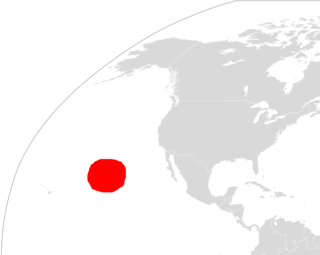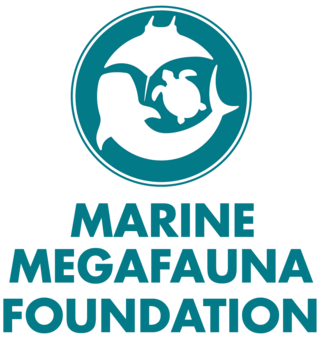
The tiger shark is a species of ground shark, and the only extant member of the genus Galeocerdo and family Galeocerdonidae. It is a large macropredator, with females capable of attaining a length of over 5 m. Populations are found in many tropical and temperate waters, especially around central Pacific islands. Its name derives from the dark stripes down its body, which resemble a tiger's pattern, but fade as the shark matures.

The leatherback sea turtle, sometimes called the lute turtle, leathery turtle or simply the luth, is the largest of all living turtles and the heaviest non-crocodilian reptile, reaching lengths of up to 1.8 metres and weights of 500 kilograms (1,100 lb). It is the only living species in the genus Dermochelys and family Dermochelyidae. It can easily be differentiated from other modern sea turtles by its lack of a bony shell; instead, its carapace is covered by oily flesh and flexible, leather-like skin, for which it is named.

Año Nuevo State Park is a state park of California, United States, encompassing Año Nuevo Island and Año Nuevo Point, which are known for their pinniped rookeries. Located in San Mateo County, the low, rocky, windswept point juts out into the Pacific Ocean about 55 miles (89 km) south of San Francisco and the Golden Gate. Año Nuevo State Natural Reserve, formerly a separate unit of the California state park system, was merged into Año Nuevo State Park in October 2008. The coastal geographic center, or coastal-midpoint of California is located at the Northern end of this park at N 37°09′58″, W 122°21'40", as the absolute geographic center of California falls at N 37°09′58″, W 119°26′58″W.

The northern elephant seal is one of two species of elephant seal. It is a member of the family Phocidae. Elephant seals derive their name from their great size and from the male's large proboscis, which is used in making extraordinarily loud roaring noises, especially during the mating competition. Sexual dimorphism in size is great. Correspondingly, the mating system is highly polygynous; a successful male is able to impregnate up to 50 females in one season.

Elephant seals or sea elephants are very large, oceangoing earless seals in the genus Mirounga. Both species, the northern elephant seal and the southern elephant seal, were hunted to the brink of extinction for oil by the end of the 19th century, but their numbers have since recovered. They are the largest extant carnivorans, weighing up to 5,000 kilograms (11,000 lb). Despite their name, elephant seals are not closely related to elephants, and the large proboscis or trunk that males have was convergently evolved.

The Hawaiian monk seal is an endangered species of earless seal in the family Phocidae that is endemic to the Hawaiian Islands.

Año Nuevo Island is a small island off Año Nuevo Point on the coast of Northern California, between San Francisco and Santa Cruz. The island has an area of 9 acres (3.6 ha). It is an important breeding site for northern elephant seals and the endangered Steller's sea lion, as well as several species of seabirds, including rhinoceros auklets, Brandt's cormorants and western gulls. Due to the number of seals and sea lions, great white sharks are frequently spotted patrolling the waters around the island. It is protected as part of the Año Nuevo State Reserve.

The Vancouver Aquarium is a public aquarium located in Stanley Park in Vancouver, British Columbia, Canada. In addition to being a major tourist attraction for Vancouver, the aquarium is a centre for marine research, ocean literacy education, climate activism, conservation and marine animal rehabilitation.

Wildlife conservation refers to the practice of protecting wild species and their habitats in order to maintain healthy wildlife species or populations and to restore, protect or enhance natural ecosystems. Major threats to wildlife include habitat destruction, degradation, fragmentation, overexploitation, poaching, pollution, climate change, and the illegal wildlife trade. The IUCN estimates that 42,100 species of the ones assessed are at risk for extinction. Expanding to all existing species, a 2019 UN report on biodiversity put this estimate even higher at a million species. It is also being acknowledged that an increasing number of ecosystems on Earth containing endangered species are disappearing. To address these issues, there have been both national and international governmental efforts to preserve Earth's wildlife. Prominent conservation agreements include the 1973 Convention on International Trade in Endangered Species of Wild Fauna and Flora (CITES) and the 1992 Convention on Biological Diversity (CBD). There are also numerous nongovernmental organizations (NGO's) dedicated to conservation such as the Nature Conservancy, World Wildlife Fund, the Wild Animal Health Fund and Conservation International.

Golfo Dulce is a gulf in Costa Rica, located at the south of the Province of Puntarenas. The inlet starts on the Pacific Ocean side of Costa Rica and extends slightly northward before turning west. The most westward part is at the city of Rincon. The bay separates the Osa Peninsula from the mainland Costa Rica.

The Marine Mammal Center (TMMC) is a private, non-profit U.S. organization that was established in 1975 for the purpose of rescuing, rehabilitating and releasing marine mammals who are injured, ill or abandoned. It was founded in Sausalito, California, by Lloyd Smalley, Pat Arrigoni and Paul Maxwell. Since 1975, TMMC has rescued over 24,000 marine mammals. It also serves as a center for environmental research and education regarding marine mammals, namely cetaceans, pinnipeds, otters and sirenians. Marine mammal abandonment refers to maternal separation; pups that have been separated from their mother before weaning. At the center, they receive specialized veterinary care: they are diagnosed, treated, rehabilitated and ideally, released back into the wild. Animals in need of assistance are usually identified by a member of the public who has contacted the center. These animals represent the following major species: California sea lions, northern elephant seals, Pacific harbor seals, northern fur seals, Guadalupe fur seals, Hawaiian monk seals, and southern sea otters. On a few occasions, TMMC has taken in Steller sea lions and bottlenose/Pacific white-sided dolphins. The only non-mammals that TMMC takes in are sea turtles.

The Red Triangle is the colloquial name of a roughly triangle-shaped region off the coast of northern California, extending from Bodega Bay, north of San Francisco, out slightly beyond the Farallon Islands, and down to the Big Sur region, south of Monterey. The area has a very large population of marine mammals, such as elephant seals, harbor seals, sea otters and sea lions, which are favored prey of great white sharks. Around thirty-eight percent of recorded great white shark attacks on humans in the United States have occurred within the Red Triangle—eleven percent of the worldwide total. The area encompasses the beaches of the heavily populated San Francisco Bay Area, and many people enjoy surfing, windsurfing, swimming and diving in these waters.

The White Shark Café is a remote mid-Pacific Ocean area noted as a winter and spring habitat of otherwise coastal great white sharks.

The fauna of Nicaragua is characterized by a very high level of biodiversity. Much of Nicaragua's wildlife lives in protected areas. There are currently 78 protected areas in Nicaragua, covering more than 22,000 square kilometers (8,500 sq mi), or about 17% of its landmass.

The southern elephant seal is one of two species of elephant seals. It is the largest member of the clade Pinnipedia and the order Carnivora, as well as the largest extant marine mammal that is not a cetacean. It gets its name from its massive size and the large proboscis of the adult male, which is used to produce very loud roars, especially during the breeding season. A bull southern elephant seal is about 40% heavier than a male northern elephant seal, which is nearly twice the weight of a male walrus, or 6–7 times heavier than the largest living mostly terrestrial carnivorans, the Kodiak bear and the polar bear.

Año Nuevo State Marine Conservation Area (SMCA) is one of two adjoining marine protected areas off the coast of San Mateo and Santa Cruz Counties, on California’s central coast. The area is approximately 55 miles south of San Francisco. The SMCA is 11.07 square miles. Except for limited taking of giant kelp, all living marine resources are protected.

Watamu Marine National Park and Reserve is located in Kenya. Established in 1968, it was one of Kenya's first marine parks. It is located about 90 miles (140 km) north of Mombasa, Kenya's second largest city. Its coral gardens are 300 metres (980 ft) from the shore and are home to approximately 600 species of fish, 110 species of stony coral and countless invertebrates, crustaceans and molluscs. Water temperature varies from 20 degrees Celsius to 30 degrees Celsius. The park was designated as a biosphere reserve in 1979.

Greyhound Rock State Marine Conservation Area (SMCA) is one of two adjoining marine protected areas off the coast of San Mateo County and Santa Cruz County, on California's central coast. The area is approximately 55 miles (89 km) south of San Francisco. The SMCA is 11.81 square miles (30.6 km2). Within the SMCA fishing and take of all living marine resources is prohibited except the recreational take of giant kelp, squid, salmon, and other finfish, subject to various conditions. Also permitted is the commercial take of giant kelp, salmon, and squid, subject to various conditions.
Barbara Block is an American marine biologist and Charles & Elizabeth Prothro Professor of Biology in Marine Sciences at the Stanford University Hopkins Marine Station and a co-director of Stanford University's Tuna Research and Conservation Center, with the Monterey Bay Aquarium. She has published numerous bodies of work throughout her career in marine biology and chemistry, mainly focusing on the biology and chemistry of metabolism in different tuna and shark species. Additionally, she has helped develop two new types of electronic tags for large pelagic predators in order to track the migrations of large oceanic predator species.

The Marine Megafauna Foundation (MMF) is a marine biology research and conservation nonprofit known for discovering, researching, and protecting large marine animals including whale sharks, manta rays, sea turtles, whales, and dugongs.




















